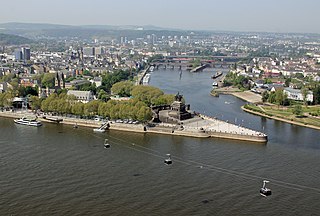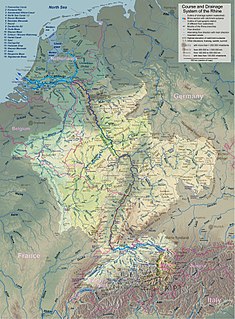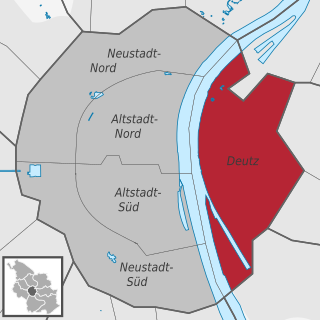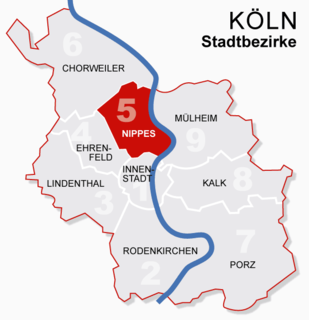
Koblenz, spelled Coblenz before 1926, is a German city situated on both banks of the Rhine where it is joined by the Moselle.

Walbrook is a subterranean river in the City of London that gave its name to a City ward and a minor street in its vicinity.

A sanitary sewer or foul sewer is an underground pipe or tunnel system for transporting sewage from houses and commercial buildings to treatment facilities or disposal. Sanitary sewers are part of an overall system called a sewage system or sewerage.

The Westbourne or Kilburn is a mainly re-diverted small River Thames tributary in London, rising in Hampstead and which, notwithstanding one main meander, flows southward through Kilburn and the Bayswater to skirt underneath the east of Hyde Park's Serpentine lake then through central Chelsea under Sloane Square and it passes centrally under the south side of Royal Hospital Chelsea's Ranelagh Gardens before historically discharging into the Inner London Tideway. Since the latter 19th century its narrow basin has been further narrowed by corollary surface water drains and its main flow has been replaced with a combined sewer beneath its route.

The London sewerage system is part of the water infrastructure serving London, England. The modern system was developed during the late 19th century, and as London has grown the system has been expanded. It is currently owned and operated by Thames Water and serves almost all of Greater London.

The Emscher is a river, a tributary of the Rhine, that flows through the Ruhr area in North Rhine-Westphalia in western Germany. Its overall length is 83 kilometres (52 mi) with an mean outflow near the mouth into the lower Rhine of 16 m3/s (570 cu ft/s).

A combined sewer is a sewage collection system of pipes and tunnels designed to simultaneously collect surface runoff and sewage water in a shared system. This type of gravity sewer design is no longer used in almost every instance worldwide when constructing new sewer systems. Modern-day sewer designs exclude surface runoff from sanitary sewers, but many older cities and towns continue to operate previously constructed combined sewer systems.

Vindobona was a Roman military camp on the site of the modern city of Vienna in Austria. The settlement area took on a new name in the 13th century, being changed to Berghof, or now simply known as Alter Berghof.
Sanitation in ancient Rome was well advanced compared to other ancient cities and was providing water supply and sanitation services to residents of Rome.
The Western Treatment Plant is a 110 km2 (42 sq mi) sewage treatment plant in Cocoroc, Victoria, Australia, 30 km (19 mi) west of Melbourne's central business district, on the coast of Port Phillip Bay. It was completed in 1897 by the Melbourne and Metropolitan Board of Works (MMBW), and is currently operated by Melbourne Water. The plant's land is bordered by the Werribee River to the east, the Princes Freeway to the north, and Avalon Airport to the west. It forms part of the Port Phillip Bay and Bellarine Peninsula Ramsar Site as a wetland of international importance. The Western Treatment Plant treats around 50% of Melbourne's sewage – about 485 ML per day - and generates almost 40,000 ML of recycled water a year.

A vacuum sewer or pneumatic sewer system is a method of transporting sewage from its source to a sewage treatment plant. It maintains a partial vacuum, with an air pressure below atmospheric pressure inside the pipe network and vacuum station collection vessel. Valves open and reseal automatically when the system is used, so differential pressure can be maintained without expending much energy pumping. A single central vacuum station can collect the wastewater of several thousand individual homes, depending on terrain and the local situation.

The Cologne Ring is a semi-circular, some 6 km long urban boulevard in Innenstadt, Cologne and the city's busiest and most prominent street system. The Cologne Ring is a four lane street and part of Bundesstraße 9.

Colonia Claudia Ara Agrippinensium was the Roman colony in the Rhineland from which the German city of Cologne developed.

The Archdiocese of Cologne is an archdiocese of the Catholic Church in western North Rhine-Westphalia and northern Rhineland-Palatinate in Germany.

Sewage is a type of wastewater that is produced by a community of people. It is characterized by volume or rate of flow, physical condition, chemical and toxic constituents, and its bacteriologic status. It consists mostly of greywater, blackwater ; soaps and detergents; and toilet paper.

The history of water supply and sanitation is one of a logistical challenge to provide clean water and sanitation systems since the dawn of civilization. Where water resources, infrastructure or sanitation systems were insufficient, diseases spread and people fell sick or died prematurely.
Ellis Sylvester Chesbrough (1813–1886) was an engineer credited with the design of the Chicago sewer system, which are sometimes known as the 'Chesbrough sewers'. This was the first comprehensive sewer system in the United States. He is responsible for the plan to raise Chicago, construction of the first water crib in Chicago, and designing the Boston water distribution system. The water system he designed for Chicago is on the National Register of Historic Places and has been designated a Historical Civil Engineering Landmark by the American Society of Civil Engineers.
The Lippeverband is a public German water board (“Wasserwirtschaftsverband”) located in Dortmund and responsible for 3.280 km² of the Lippe catchment from Lippborg down to the river Rhine with 1.4 Mio. citizens. The main tasks are wastewater discharge and treatment, flood protection, groundwater management, settlement of claims caused by hard coal mining, river restoration and protection of ecosystems.

The Emschergenossenschaft is the oldest and biggest public German water board, („Wasserwirtschaftsverband”) located in Essen and responsible for the 865 km² Emscher catchment with 2.2 Mio. citizens. The main tasks are wastewater discharge and treatment, flood protection, groundwater management, settlement of claims caused by hard coal mining, river restoration and protection of ecosystems.


























